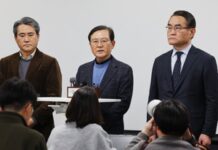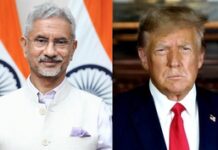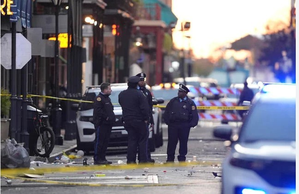New Delhi: The terror attack carried out by an ISIS convert — Shamsuddin Jabbar — at New Orleans’s famed Bourbon Street on New Year’s Day, has drawn attention to the reality that Islamic radical forces were down but not out and were present across the world as ‘sleeper cells’ and ‘lone wolves’ determined to execute their plans — primarily against the US-led West and their allies.
Terrorism by definition is a resort to ‘covert’ violence for a perceived political ’cause’, calling for a degree of ‘commitment’ that was determined by ‘motivation’.
Since the faith-based motivation behind the call of Jehad could be very strong indeed, it is not surprising that a ‘radicalised’ mind could even take on a ‘suicide mission’ like what Shamsuddin did.
He is said to be a lone wolf according to the evidence surfacing so far.
Born in Texas — Shamsuddin had rented an accommodation in New Orleans to plan the attack.
Given the seriousness of the incident, US President Joe Biden and First Lady Jill Biden visited New Orleans to meet the families of the victims.
In the background of this case of terrorism on US soil, three serious developments would add to the geopolitical concerns of President-elect Donald Trump.
First, it is reported that in recent months a few terror suspects were already on the radar of the FBI from which it could be inferred that the US was not beyond the reach of Islamic radicals, particularly at a time when cyber channels and social media were being freely used for indoctrination of vulnerable citizens.
The challenge for American security agencies had suddenly enlarged as they have the responsibility of unearthing all such channels and neutralising them — this in fact is the case with the security setup of all democratic countries as well.
The second notable feature of this case is that the perpetrator of terror was an Army veteran who had served in Afghanistan for a spell, remained in active service till 2015 and reportedly put in his papers in 2020 as Staff Sergeant.
His case showed that ‘radicalisation’ can influence even educated and reasonably well-employed persons and not only the poor and the frustrated youth — Jabbar though was said to be in financial trouble after his first divorce.
In one of the videos made before the incident, he talked of the ‘war between the believers and non-believers’ and acknowledged his allegiance to ISIS.
A leaflet of ISIS was said to have been recovered from the back of his truck.
It may be mentioned that the ‘war on terror’ led by the US following 9/11, was essentially an American combat against Islamic radicals headed by Al Qaeda in Afghanistan and its competitor, the Islamic State of Iraq and Syria (ISIS) in the second theatre of the said ‘war’.
In Afghanistan despite the ‘war on terror’, the US was compelled to withdraw its troops from there after getting into an agreement with the Taliban backed by Al Qaeda and witnessing the reinstallation of the Kabul Emirate headed by Taliban, in 2021.
That Pakistan had cleverly played a mediatory role at Doha and helped the Islamic Emirate of Afghanistan intending to acquire ‘strategic depth’ against India, is another story.
Shamsuddin Jabbar must have watched with possible admiration how Islamic radicals had stood their grounds against the might of the ‘US-led world coalition’.
This draws attention to the third aspect of the New Orleans episode which is that the terrorist in this case became an admirer of ISIS rather than Al Qaeda because it is ISIS that had become the face of Islamic radical forces — after Osama bin Laden and his successor in Al Qaeda, Ayaman Al Zawahiri, had been eliminated by the US in special military operations.
The attack at New Orleans fully conformed to the modus operandi of terrorists.
The attacker used a rented pickup truck to run over the crowds on pavements celebrating New Year’s Day and opened indiscriminate fire killing a total of 14 innocent people and injuring 35 others.
He had loaded the truck at his home place in Texas with automatic arms, explosives and IEDs and reportedly planted two of the IEDs at important junctions in New Orleans city hiding them in coolers.
He had the detonators with him which he could not use before he died in the encounter with the Police. Shamsuddin shared the hatred radical forces like Al Qaeda and ISIS had for the US — today’s Islamic radicals carry the historical legacy of the Wahhabi Jehad that the leading Ulema of the times had called for in the 19th century, against the Western encroachment on Muslim lands.
Wahhabis contended that Islam was suffering a political decline after a thousand years of its advancement because Muslim rulers had deviated from the puritan Islam that existed in the times of the four ‘pious’ caliphs. The call for Jehad thus was accompanied by the revivalist idea of a return to the original Islamic practices and mandate.
‘Radicalisation’ bred faith-based terrorism which could be checked if a voice against it arose from within the community itself — a consensus needed to emerge in the Islamic world that terrorist violence cannot be justified on any ground.
It is important to note that the appearance of a new Cold War on the horizon between the US on one hand and the China-Russia axis on the other — which is basically a political divide — was getting bolstered by religion-based alignments, particularly in the Middle East.
Iran is anti-US because Shia fundamentalism is against Capitalism — it has brought the radicalised Hamas under its embrace since Sunni radicals also considered the US-led West as their first enemy.
Bashar Al Assad, the Syrian President was an Alawite Shia who enjoyed the support of Iran whereas the US backed the anti-Assad civil war of Islamic forces that were on the right side of the West.
They carried the historical memory of the rise of the Muslim Brotherhood movement in Syria and Egypt in 1928 in opposition to the ‘nationalist pro-Soviet’ Arab rulers of these countries at that time.
Islamic radical forces were on their own fighting against the present Assad regime separately, for establishing an Emirate in Syria.
Russia and China, unsurprisingly, backed the Syrian President because of their political opposition to the US. Saudi Arabia, the UAE and Kuwait are close allies of the US and they have been amenable to the mediation by the US for getting them to join the so-called Abrahamic accord with Israel.
Islamic radical forces are hostile to Saudi Arabia because of the latter’s closeness to the US.
Iran’s hostility towards Saudi Arabia is for political reasons and also because of the Shia-Sunni religious contradiction.
Significantly, ISIS felt offended by the Russian support to Bashar Al Assad and its regional face — ISIS-K –carried out a terror attack on a concert hall in Moscow in March last using grenades and automatic rifles as a result of which 130 persons were killed and hundreds of others injured.
The Moscow attack was also possibly meant to administer a warning to Russia — after the happenings in Chechnya — not to come in the way of the spread of ‘radicalisation’ in Central Asia.
In the backdrop of the Russian invasion of Afghanistan and the subsequent success of the anti-Soviet armed campaign there — which was run on the war cry of Jehad and in which Islamic radical forces led by Al Qaeda were also fully involved — the antipathy of ISIS towards Russia is understandable.
It is on the eve of swearing in of Donald Trump as the new President of the US that a major terror strike has been reported from that country.
The President-elect has not yet given out the framework of his national strategy but among the few indicators of the same available so far, his denunciation of faith-based terrorism comes off as the most unambiguous element of his policy approach.
Trump is not — judging from his record — an advocate of European Union and NATO and this might help him to elicit a Russian response of moderation in the Ukraine-Russia war.
On Israel’s action in Gaza, Trump might like Israel to ‘declare victory’ early enough so that the Palestinian issue did not remain an ongoing irritant on the domestic front.
The new President would have taken cognisance of the adverse fallout of ‘radicalisation’ on American interests and realised that terrorism was a concern both the US and India faced as the two largest democracies.
This should favour the continuance of strategic friendship between India and the US — that India understands what lay at the roots of radicalisation should further help this relationship.
India’s security concerns revolve a lot around the Sino-Pak axis that was now actively engaged in covert operations against this country — use of Chinese drones by Pakistan to drop arms and narcotics in the border states of Punjab and Kashmir being a telling illustration of how these two hostile neighbours were trying to damage India’s internal security.
It has to be seen how the Trump Presidency would look at Pakistan, a country that remained under the sway of an army with a highly ambiguous approach to Islamic radical forces.
Tehreek-e-Taliban Pakistan (TTP) is trying to push Pakistan towards a more fundamentalist Islamic rule.
It may be mentioned that Khyber Pakhtunkhwa (KP) where TTP is entrenched was the epicentre of the anti-British ‘Wahhabi revolt’ on the Indian subcontinent which had left this territory highly radicalised.
India’s foreign policy framework of favouring bilateral and even multilateral friendships on the basis of shared security and economic interests, looking at the world as a multipolar order and speaking up for global peace and development of humanity, should fit in well with the Trump Presidency.
The ‘America First’ doctrine of Trump may be designed more to serve the US economic interests and may not necessarily go with an ‘interventionist’ approach or a tendency to call the shots militarily in various theatres of conflict.
The ‘country first’ outlook need not create an Indo-US contradiction.
Moreover, India is a leader in Information Technology and it can be presumed that it will hold its ground in the emerging sphere of Artificial Intelligence (AI) as well.
India and the US can together take the cause of the ‘knowledge economy’ forward for the general good of the world. Post-Cold War, we are in the era of ‘proxy wars’ where frontal military attacks are giving way to ‘covert’ offensives designed to weaken and vanquish the opponent.
Apart from cyber attacks, externally instigated separatist movements, insurgencies fuelled from outside and the use of social media as a weapon of combat by building ‘narratives’ through misinformation and deepfakes to bring down a regime, are the new variants of ‘asymmetric warfare’ that added to the challenge of safeguarding national security.
Friendly countries must understand each other’s concerns in this regard.
International cooperation must be strengthened against the threats of terrorism, narcotics trade and human trafficking and hopefully, India and the Trump administration will find themselves on the same side of the fence in handling these global issues.
(The writer is a former Director of the Intelligence Bureau. Views are personal)
–IANS
dcpathak/khz






























